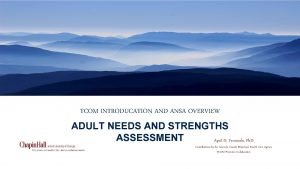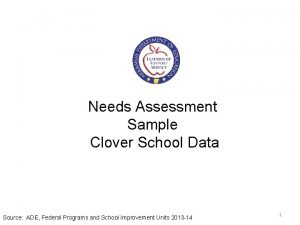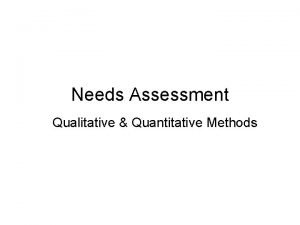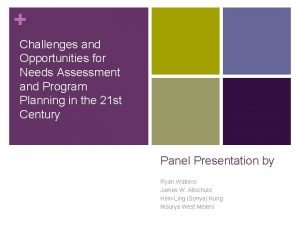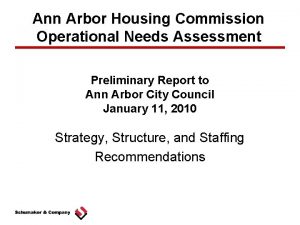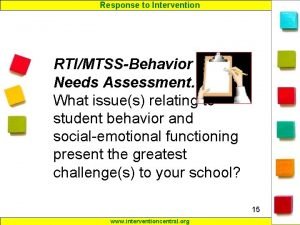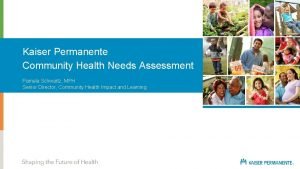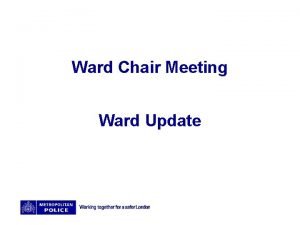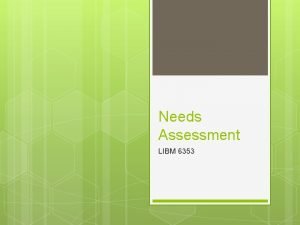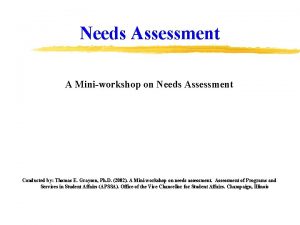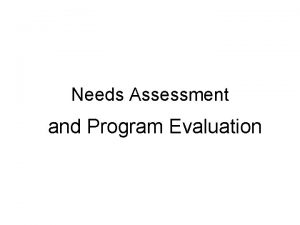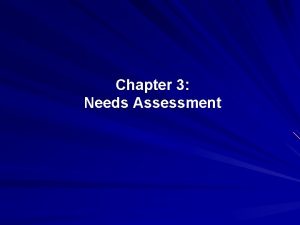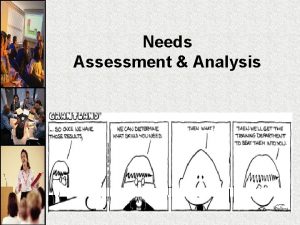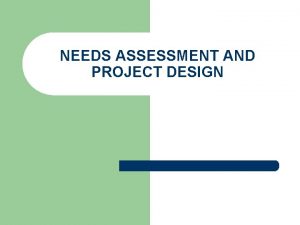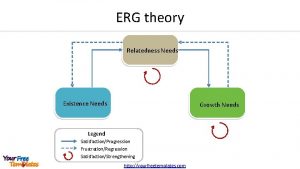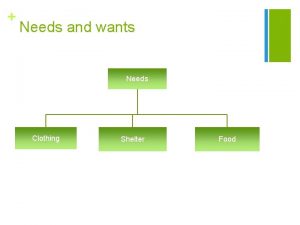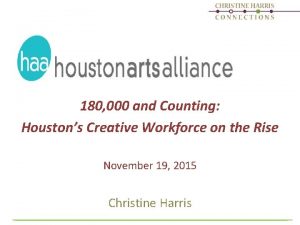THIRD WARD NEEDS ASSESSMENT Houstons Third Ward is
















- Slides: 16

THIRD WARD NEEDS ASSESSMENT

Houston’s Third Ward is a Historic African American Community

Third Ward Comprehensive Needs Assessment Ø Recruited and trained residents to serve as community researchers, paying a living wage of $15. 00 Ø Engaged community researchers to assist with survey development Ø Compensated each household $50. 00 to participate Ø Community partners developed a Third Ward Residents Resource House to research participants with information on housing, employment, education, and social services

Survey Domains • • Physical Health Behaviors Mental Health Housing Employment Income Education • • Food Access Transportation Safety/Security Social Support Social Services Civic Engagement Perceptions of the Neighborhood

Progress ØPhase I and Phase II (45 S (north) Scott (east), 288 (west), Alabama (south) ØTotal surveyed 1301 ØRR 61. 1% ØPhase III- extend Alabama to Blodgett to the south ØTotal sample 1, 160 ØTotal surveyed 315 ØRR 27. 1%

Survey Demographics Mean age 54 Race • 88% African-American • 5% White • 4% Hispanic Household Income: • 51% of respondents <$10, 000 • 16% of respondents $10 K-$19, 999 Education • 3% less than 8 th grade • 16% some high school • 37% high school diploma or a GED • 20% some college but no degree • 10% technical school or associates degree • 9% bachelors degree • 4% advanced degree

Employment Respondents With Employment 26% are employed full-time 12% employed part-time 9% self-employed 1% seasonal 2. 26% students Respondents Without Employment 22% retired 10% not working and looking for work 3% not working and not looking for work 16% unable to work 97% unable to work due to health problems

Industry or type of job residents want to work in. Future Employment Health Food Industry Hospitality Retail Administrative Construction Personal Services Manufacturing Transportation Maintenance Education Child Care Technology Energy Technology Politics Arts Number of Residents 60 59 39 37 30 28 27 24 23 17 14 13 11 11 11 9 9 Average Age 40. 89 38. 54 36. 64 34. 32 42. 17 46. 17 35. 88 45. 79 44. 5 42. 47 38. 78 34. 84 37. 54 43. 9 37. 54 37. 55 36. 77

Built Environment Transportation 27% use bus as primary mode of transportation 9% bike or walk Biking and Walking 17. 64% report difficulty in walking/biking Things that stop people from walking or biking 68% Not enough walking/biking paths 70% poor quality 67% Safety/fear of crime 63% Intersections difficult to cross 80%+ report would walk/bike more if infrastructure improved

Safety Neighborhood violence 15% had someone in household experience violence or abuse 85% hear gunfire from their home 60% fear of crime limits where they would go Safety/Security 66. 9% safe walking in day--> 31. 38 % at night Extremely concerned about: drug dealing (48%), theft (45%), drug use (46%), property damage (41%), gang (44%), child abuse/neglect (41%), prostitution (41%), domestic violence (41%), & traffic (40%)

Housing 82% are renters, 17% are homeowners 27% report their monthly payment or rent has increased over the past year 22. 4% of respondents are worried about having to move within the next year, with rent being the most common reason 55% of respondents have lived in Third Ward over 15 years, 1 and 5 of these residents are worried about having to move Housing Quality 41% have pests 25% have lead paint in their homes 23% have mold 8% have no heat or AC 6% have no running hot or cold water

Social Determinants Access to healthcare 69% of the respondents have health insurance, with 17% employer based insurance, 32% Medicaid and 20% Medicare 52% have primary provider, 48% do not 9% couldn’t see a mental health /substance abuse professional when needed Food insecurity 51% have experienced food insecurity, compared to 11. 8% nationally 52% of all respondents utilize SNAP benefits; 60% of those with food insecurity receive SNAP benefits

Needed Services Food assistance (80%) Domestic violence counseling (12%) Substance abuse counseling (13%) Inpatient mental health (18%) Outpatient mental health (23%) Help with utilities (67%) Help with rent (63%) Help finding housing (59%) Childcare (25%) Job training (39%) Employment (43%) Educational opportunities (47%)

Health Conditions Self-reported health: 53% good or average health; 8% report poor health 11% Asthma 14% Diabetes 9% Heart conditions 37% HTN (national prevalence 39% men, 43% women) 5% Kidney/bladder Health behaviors Avg. BMI 27. 9 37% < 25 29% 25 -30 34% >30 Exercise 56% engage in moderate exercise 3+ times/week 26% engage in high exercise 3+ times/week

Mental Health Lifetime Prevalence of Mental Disorder by Diagnoses, Third Ward vs. National Estimates 25. 0% 19. 1% 20. 0% 17. 0% 16. 7% 15. 0% 10. 0% 7. 6% 7. 1% 5. 4% 5. 0% 3. 6% 2. 8% 3. 4% 1. 0% 0. 0% Anxiety Bipolar Disorder Depression Third Ward National Post-traumatic Stress Disorder (PTSD) Schizophrenia

Collective Efficacy Defined: Trust among residents and willingness to intervene to achieve social control. Measures 86. 5% check on elderly neighbor 80% give neighbor a ride 80% watch a neighbor’s children 77% check neighbor’s mail Civic Engagement: 64. 3% voted in Presidential election in 2016 78% satisfied living in Third Ward
 Impacted molar surgery
Impacted molar surgery Primary needs and secondary needs
Primary needs and secondary needs Satisfaction
Satisfaction Simple claustral complex
Simple claustral complex Strategic gender needs and practical gender needs
Strategic gender needs and practical gender needs Target needs and learning needs
Target needs and learning needs Odontoclasia definition
Odontoclasia definition G j mount classification
G j mount classification Adult needs and strengths assessment
Adult needs and strengths assessment Ade needs assessment
Ade needs assessment Difference between qualitative and quantitative
Difference between qualitative and quantitative Community needs assessment steps
Community needs assessment steps Challenges of needs assessment
Challenges of needs assessment Housing needs assessment
Housing needs assessment Mtss needs assessment
Mtss needs assessment Pamela schwartz kaiser
Pamela schwartz kaiser Transportation needs assessment
Transportation needs assessment








